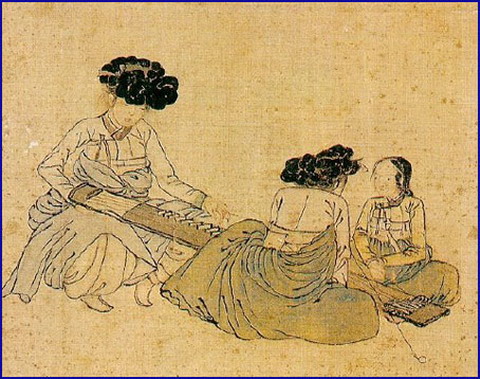- Geomungo
Infobox Korean name

hangul=거문고 "or" 현금
hanja=(none) "or"
rr=geomun(-)go "or" hyeon(-)geum
mr=kŏmun'go "or" hyŏn'gŭm
The "geomungo" (also spelled "komungo" or "kŏmun'go") or "hyeongeum" (also spelled ("hyongum" or "hyŏn'gŭm") is a traditionalKorea n stringedmusical instrument ofzither family instrument with both bridges andfret s. Scholars believe that the name refers toGoguryeo and translates to "Goguryeo zither" or that it refers to thecolour and translates to "black crane zither".History
The instrument originated circa the fourth century (see
Anak Tomb No.3 infra) through the7th century from the kingdom of Goguryeo, which comprises the northern part of modern-day southernManchuria and the northern and central parts of theKorean peninsula , although the instrument can be traced back to the4th century .According to the "
Samguk Sagi " (Chronicles of the Three Kingdoms), written in1145 , the "geomungo" was invented by prime ministerWang San-ak by using the form of the ancient Chinese instrument "guqin " (also called "chilhyeongeum", literally "seven-string zither"). After his death, the instrument was passed down to Ok Bogo, Son Myeong-deuk, Gwi Geum, An Jang, Cheong Jang, and Geuk Jong, while being widely spread over the kingdom.Archetype of the instrument is painted in
Goguryeo tombs. They are found in the tomb of Muyongchong andAnak Tomb No.3 .Construction
The "geomungo" is approximately 162 cm long and 23 cm wide (63.75 inches long, 9 inches wide), and has movable bridges called Anjok and 16 convex frets. It has a hollow body where the front plate of the instrument is made of
paulownia wood and the back plate is made of hardchestnut wood. Its six strings, which are made of twistedsilk passed through its back plate. The pick is made from bamboo sticks in the size of regular household pencil.Playing
The "geomungo" is generally played while seated on the floor. The strings are plucked with a short
bamboo stick called "suldae", which is held between the index and middle fingers of the right hand, while the left hand presses on the strings to produces various pitches. The most typicaltuning of the open strings for the traditional Korean music is E flat, A flat, C, B flat, B flat, and B flat anoctave lower than the central tone. The instrument is played in traditional Korean court music and the folk styles of sanjo andsinawi .Due to its characteristically percussive sound and vigorous playing technique it is thought of as a more "masculine" instrument than the 12-string
gayageum (another Korean zither); both instruments, however, are played by both male and female performers.The Korean-born, U.S. resident "geomungo" performer and composer
Jin Hi Kim plays a custom-made electric "geomungo" in addition to the regular instrument. [http://www.mediateletipos.net/wp-content/images/2006/06/electric_260x437.jpgphoto]ee also
*
Traditional Korean musical instruments
*Korean music
*List of Korea-related topics External links
* [http://www.geomungo.com/ Information Website]
Wikimedia Foundation. 2010.
